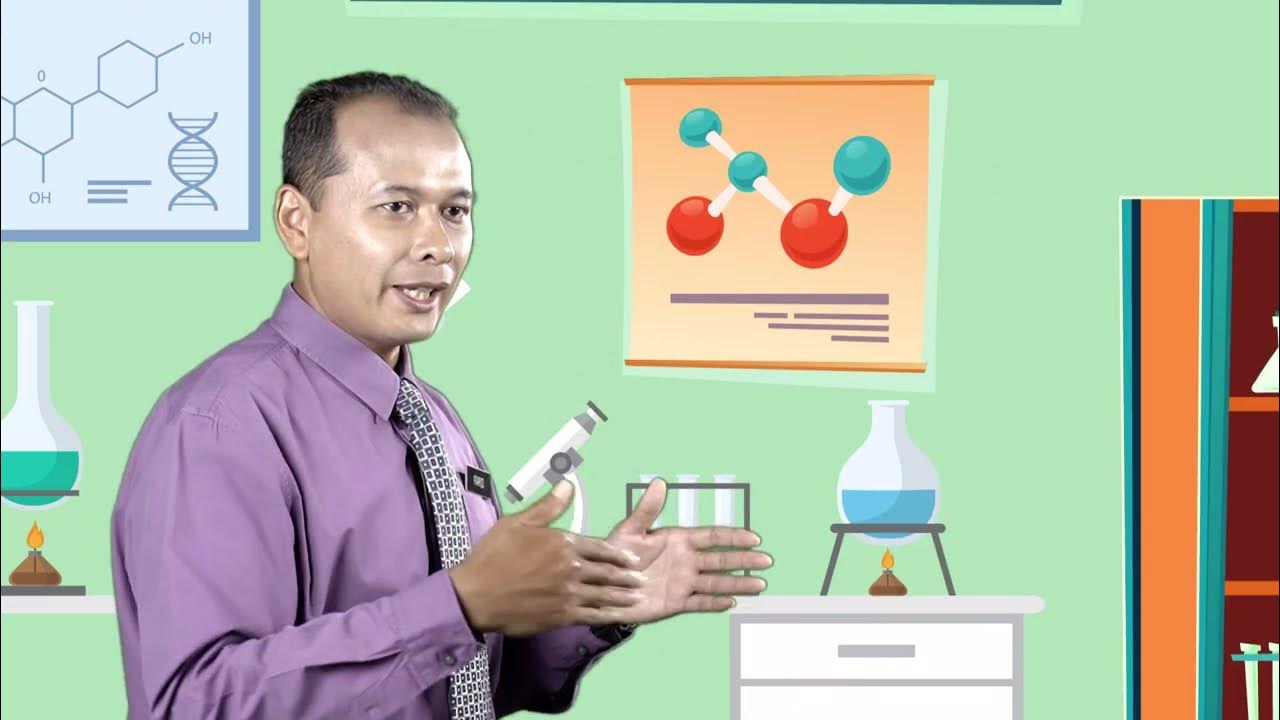BAB 5 UNSUR SENYAWA DAN CAMPURAN - Bagian 2 (IPA Kelas 8 Kurikulum Merdeka)
Summary
TLDRThis video lesson explores key concepts of compounds and mixtures in chemistry, specifically for 8th-grade science. It defines compounds as substances made of two or more elements chemically bonded together, such as H2O (water) and HCl (hydrochloric acid). It differentiates between organic compounds (carbon-based) and inorganic compounds (metallic or non-metallic). The lesson also explains mixtures, both homogeneous (like syrup) and heterogeneous (like oil and water), highlighting their separation methods. Further, it covers the characteristics of solutions, suspensions, colloids, and aerosols, using everyday examples to illustrate these scientific concepts.
Takeaways
- 😀 Compounds are pure substances that consist of two or more elements, which can be broken down into simpler substances through chemical processes.
- 😀 Molecules in compounds are formed when atoms bond together, either through covalent or ionic bonds.
- 😀 Compounds can be classified into two types: organic and inorganic compounds. Organic compounds contain carbon and hydrogen, while inorganic compounds do not.
- 😀 Organic compounds are generally derived from living organisms or created in laboratories, with carbon atoms as their main structural component.
- 😀 Inorganic compounds are typically made of metal atoms bonding with other metals or non-metals.
- 😀 Mixtures consist of two or more substances that maintain their original properties and can be separated by physical methods.
- 😀 Mixtures are categorized into homogeneous (same composition) and heterogeneous (different composition) types.
- 😀 A solution is a mixture formed by dissolving a solute in a solvent, and its concentration can vary from dilute to saturated.
- 😀 A suspension is a type of mixture where solid particles do not dissolve in a liquid but remain dispersed.
- 😀 Colloids are mixtures with properties between solutions and suspensions, where particles are dispersed but not dissolved.
- 😀 Different types of colloids include sol, emulsion, foam, gel, and aerosol, each characterized by different phases of dispersed particles and mediums.
Q & A
What is the definition of a compound in chemistry?
-A compound is a pure substance made up of two or more elements chemically bonded together. It can be broken down into simpler substances through chemical processes.
What are the two types of chemical bonds that can form in molecules?
-The two types of chemical bonds are covalent bonds and ionic bonds. Covalent bonds involve the sharing of electrons, while ionic bonds involve the transfer of electrons.
What is the difference between a molecule of an element and a molecule of a compound?
-A molecule of an element consists of atoms of the same type, such as O2 (oxygen). A molecule of a compound consists of atoms from different elements, such as H2O (water), which is made of hydrogen and oxygen.
What are organic compounds, and how do they differ from inorganic compounds?
-Organic compounds are mainly made of carbon and hydrogen atoms and are often derived from living organisms. In contrast, inorganic compounds typically involve metals or non-metals and do not rely on carbon as a central element.
What are some examples of organic compounds mentioned in the script?
-Examples of organic compounds mentioned in the script include glucose (C6H12O6) and other compounds containing carbon and hydrogen.
What is the difference between a homogeneous mixture and a heterogeneous mixture?
-A homogeneous mixture has a uniform composition and consists of only one phase, while a heterogeneous mixture has an uneven composition and contains two or more phases.
What is a solution, and how is it different from other types of mixtures?
-A solution is a type of mixture where a solute is dissolved in a solvent. It is homogeneous, meaning the components are evenly distributed. This contrasts with suspensions, where the solute particles are not dissolved.
What is the role of a solvent in a solution?
-A solvent is the substance that dissolves the solute in a solution. It is typically present in a greater amount compared to the solute.
What are suspensions, and how do they differ from solutions?
-Suspensions are mixtures where solid particles are dispersed in a liquid but do not dissolve. Unlike solutions, where the solute is fully dissolved, the particles in a suspension can settle over time.
What is a colloid, and how does it differ from a suspension?
-A colloid is a mixture where the dispersed particles are smaller than those in a suspension and do not settle over time. Colloids have properties that are intermediate between those of a solution and a suspension.
Outlines

Cette section est réservée aux utilisateurs payants. Améliorez votre compte pour accéder à cette section.
Améliorer maintenantMindmap

Cette section est réservée aux utilisateurs payants. Améliorez votre compte pour accéder à cette section.
Améliorer maintenantKeywords

Cette section est réservée aux utilisateurs payants. Améliorez votre compte pour accéder à cette section.
Améliorer maintenantHighlights

Cette section est réservée aux utilisateurs payants. Améliorez votre compte pour accéder à cette section.
Améliorer maintenantTranscripts

Cette section est réservée aux utilisateurs payants. Améliorez votre compte pour accéder à cette section.
Améliorer maintenantVoir Plus de Vidéos Connexes

Kurikulum Merdeka Rangkuman Materi IPA Kelas 8 Bab 5 Unsur Senyawa dan Campuran

Unsur, Senyawa, dan Campuran Kelas 8 | IPA Bab 5 Kurikulum Merdeka - Lengkap

Kimia Dasar - Mengenal Unsur dan Senyawa (Seri 001)

IB Chemistry Topic 1 Stoichiometric relationships Topic 1.1 Introduction to Chemistry SL

Form 1 | Science | DLP | Periodic Table | DLP0012

Is Matter around us Pure? Full Chapter (Animation) | Class 9 Science chapter 2 | CBSE | NCERT
5.0 / 5 (0 votes)
